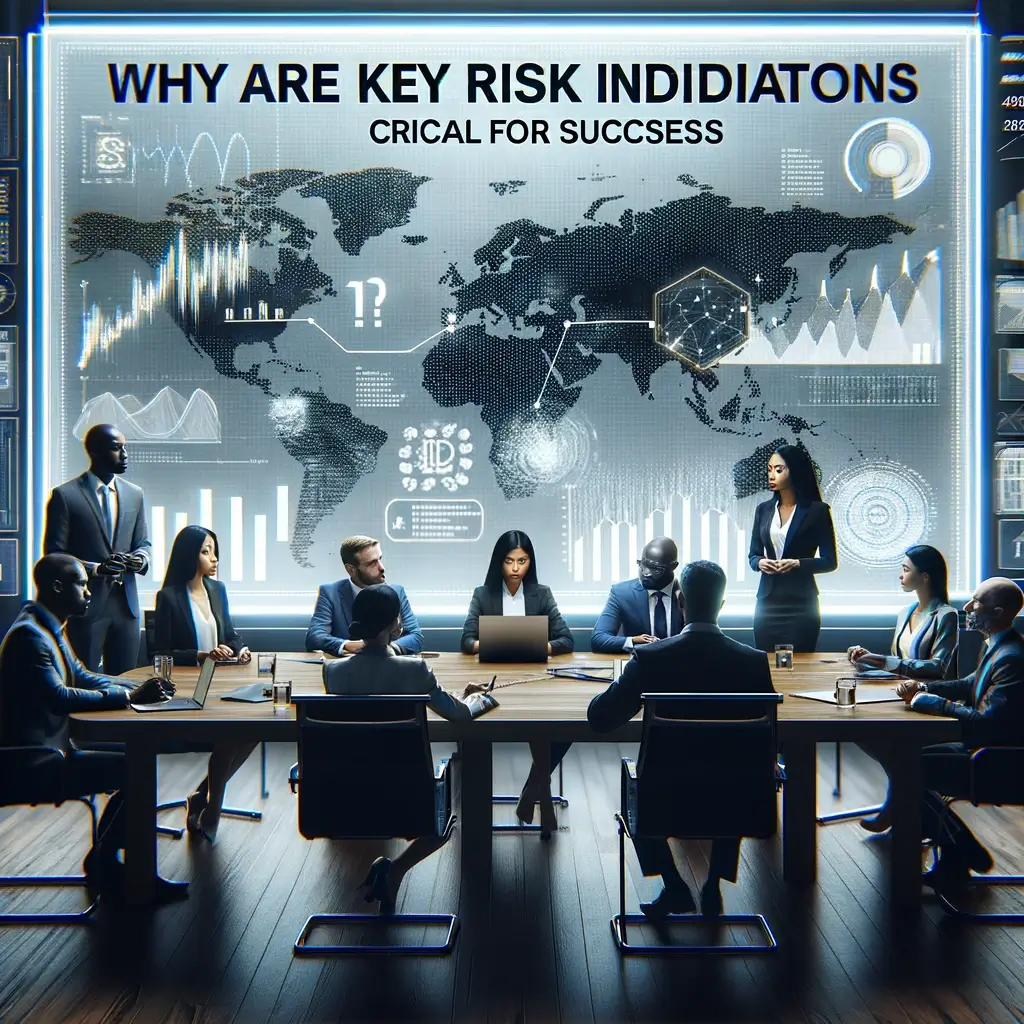Anticipating, understanding, and responding to potential risks is critical to an organization’s success in any fast-paced and highly competitive business landscape.
Central to this are Key Risk Indicators (KRIs), quantifiable metrics that provide invaluable insight into the likelihood of a future adverse event.
Properly defining, measuring, and acting upon these indicators serves as a powerful risk management tool, enabling businesses to make informed strategic decisions, drive innovation, create more resilient business models, and ensure sustainable success.
Understanding Key Risk Indicators (KRIs)
The business world is rife with uncertainties and potential pitfalls, making risk assessment an indispensable tool in the entrepreneur’s arsenal.
Prominently standing out in this toolkit are the Key Risk Indicators (KRIs), pivotal metrics that offer insightful glimpses into potential dangers lurking around the corner.
Understanding Key Risk Indicators
In essence, KRIs are vital data points that help businesses detect changes in risk exposure early on. They are the alarm bells that alert operators to shifts in the operational landscape, paving the way for preemptive action to mitigate or avoid impending threats.
A well-crafted KRI can expose an unfavourable pattern before it spirals into a full-blown crisis, safeguarding the corporation’s valuable resources – time, money, and reputation.
The KRI Advantage
At first glance, keeping tabs on KRIs may seem like an optional chore. But while businesses can indeed survive without them, they certainly cannot thrive. Forewarned is forearmed, they say, and monitoring KRIs is akin to having a robust, proactive defence mechanism in place.
In this unrelenting corporate race, speed is of the essence. Market conditions can pivot in the blink of an eye, making early warning a priceless asset.
Knowing where your business stands regarding risk exposure provides valuable time – time to mobilize resources, adjust strategies, and stay ahead of the curve.
Beyond this, efficient KRI management fosters an environment of transparency. It showcases a company’s commitment to good governance, boosting investor confidence and, in turn, stock value.
It also ensures regulatory compliance, killing two birds with one stone per se.
Understanding and Managing Your KRIs
KRIs are as diverse as the businesses they serve. A pertinent KRI for a real estate firm might prove irrelevant for a tech start-up. Therefore, it is crucial to identify the indicators that are germane to your company’s unique landscape.
Traditionally, KRIs find their roots in financial factors like liquidity ratios, credit scores, or profitability metrics. However, in a more comprehensive view, they can extend into operational performance, customer satisfaction, employee health, and safety.
Once you’ve identified your KRIs, monitoring them should be embedded in your daily operations. Enterprises generally integrate this into their risk assessment structures.
Regularly updated KRI dashboards are popular, providing a high-level glimpse of the standing risks.
All in all, Key Risk Indicators are not just a fancy measuring tool for those at the top echelons of the business world. They are an integral aspect of effective business management, a beacon to navigate the treacherous terrain of corporate landscapes.
Paying attention to your KRIs is a small investment with huge payoffs, making it a non-negotiable for businesses aspiring for long-term growth and sustainability.

Role of KRIs in Risk Management and Strategy Planning
Transitioning from understanding KRIs to the actual implementation in an organization is a strategic process requiring extensive business acumen.
Let’s apply our knowledge of KRIs to actually manage business risks and plan strategically, considering their diversity, relevance, and impact on different facets of businesses.
KRIs remarkably contribute to sharpening a company’s strategic planning. Executing strategic planning necessitates a firm understanding of both external and internal risks.
Because these key risk indicators bring potential threats to the surface, they afford businesses the opportunity to adjust their strategy proactively.
This foresight enables companies to tailor their ambitions and budgets with a clear visual of potential risks, thereby saving costs and resources and protecting their reputation in the market.
KRIs also facilitate focused decision-making, essentially leading to the development of a solid strategic planning framework.
Managers can make informed decisions when they understand what risks are more likely to affect their operations. They provide answers to pertinent questions like:
How should we allocate resources? Where can we capitalize on opportunities? What areas need improvement? By leading decision-makers to such introspection, KRIs are indeed a business’ lighthouse in a sea of risks.
Driving innovation is yet another tangible benefit from properly monitoring KRIs. Once a business can identify and anticipate risks and challenges, it’s positioned to design innovative solutions.
Adaptability is crucial in today’s swiftly changing market, and KRIs guide businesses in deciding where and how to innovate to stay competitive. Therefore, effectively managed KRIs not only control risks but also drive growth and success.
But that’s not all. KRIs are a cornerstone in refining a company’s risk appetite – the total amount of risk an organization is willing to accept in pursuit of its strategy.
Leaders can use KRIs to gauge their organization’s vulnerability to particular risks, thereby ascertaining their risk tolerance levels.
Defining their risk-taking capabilities allows businesses to strategically position themselves in the corporate arena and focus on aligned initiatives.
Yet, all these potential benefits hinge on how accurately a business is able to select, monitor, and interpret the right KRIs. Remember, numerous variables can become KRIs, extending beyond financial factors into operational performance, customer satisfaction, employee health and safety, and more.
Thus, the power lies in fostering an environment brimming with regular discussions about risks, training employees about KRIs, encouraging open communication, and instilling a strong risk-aware culture.
This conversation is only beginning. As the business environment evolves, new KRIs will emerge, making risk management and strategic planning no longer separate realms but intertwined facets in the wheel of successful business management.
Refining your understanding of Key Risk Indicators (KRIs) can be the key to business success, whether you’re an established business leader or an emerging entrepreneur.

How KRIs Drive Business Innovation
Developing and staying competitive in today’s fast-paced, exponentially evolving business landscape demands more than just understanding key risk indicators (KRIs); harnessing the power of KRIs can truly drive business transformation.
Strategic planning forms the backbone of any thriving organization. Here, KRIs – often underrated – rise as a robust tool to hone strategic foresight.
In essence, they provide not only a comprehensive picture of potential business risks but also deliver prescient insights into unexplored opportunities.
The cogs of the strategic planning machine are oiled by a clear understanding of potential roadblocks and opportunities, all accurately reflected in KRIs’ findings.
Imagine the power of informed, data-driven decision-making. It’s like having a crystal ball that outlines future dangers and reveals promising paths to business growth. KRIs, effectively used, guide this process.
Market disruptors innovate and pivot business strategies based on analyzed KRIs for market conquests.
Not all risk is created equal. Calibrating a company’s risk appetite is a delicate balancing act. KRIs offer an important lens through which to view this complex process.
They pave the way for smarter risk management, pushing organizations out of their comfort zones and into dynamic areas. In the true spirit of innovation, risk and reward often go hand-in-hand, making an informed risk appetite the starting point for groundbreaking business ideas.
Sure, picking the right KRIs to monitor and interpret is no small feat. But without this critical first step, you’re navigating blind.
It’s paramount to factor in business size, industry standards, competitive landscape, and specific business objectives for nuanced KRI selection. Such specificity births unique KRIs, which can spring awe-inspiring, powerful business innovation.
Fostering a risk-aware culture in the modern business arena is no longer optional. A top-down approach encouraging employees to track and evaluate KRIs can catapult a company from stagnancy to constant evolution.
Harnessing the collective intelligence of a risk-aware workforce can significantly magnify the KRI impact, fostering a culture that eagerly embraces innovation.
Tracking the evolving nature of KRIs is crucial for their effective usage. With external threats like cyber-attacks and data breaches becoming increasingly common, KRIs must be adjusted to account for these new risks. Similarly, the COVID-19 pandemic showcased the importance of health and safety KRIs and the need for readiness to tackle unexpected business disruptions.
All things considered, mastering Key Risk Indicators holds tremendous significance for any business aiming for long-term success. Kris, a once-ignored facet of risk management, now stands front and center as an untapped well of potential for creating innovative business strategies.
So, dare to venture into the compelling world of KRIs and watch as your business transcends uncharted territories of innovation and unparalleled success.

Implementing KRIs for Sustainable Success
Harnessing the Predictive Power of KRIs for Long-term Success
Key Risk Indicators (KRIs) are not simply a reactive means for businesses to identify and address risks after they have materialized. When used correctly, they can serve as an ingenious predictive tool that allows businesses to foresee possible disaster scenarios, prepare accordingly, and thus steer clear of major setbacks.
Organizations can proactively manage risks by continually assessing and monitoring KRIs.
One often overlooked beneficial aspect of KRIs is their predictive power in strategic planning. To exploit this facet, businesses must transition from viewing KRIs as mere measuring tools to leveraging them as a strategic lens directing the corporate vision.
Doing so equips businesses with the ability to make accurate predictions about future performance while effectively identifying areas ready for growth ventures and innovation.
Decision-making stands at the nexus of risk and return, making KRIs an absolute necessity in this process. Kris can provide invaluable guideposts for decision-makers that allow them to assess potential ventures in light of the associated risks.
Doing so aids in forging a path toward data-driven decision-making backed by concrete risk assessments.
A strong risk management framework that includes KRIs is not solely contingent on its structural design but equally on its cultural application.
Hence, fostering a culture that acknowledges, understands, and embraces risk management is crucial. This culture should be one that acknowledges the dynamic nature of business risks and is flexible enough to reassess and redefine KRIs as industry landscapes change.
Selecting the right KRIs demands setting your sights on more than the balance sheet. While financial indicators are undoubtedly vital, an efficient KRI selection process also incorporates intangible factors such as operational efficiency, brand reputation, or customer loyalty.
This combination equips businesses with a more holistic view of their risk profile, substantively contributing to a versatile risk management strategy.
Recognizing the evolving nature of risks and adapting KRIs to account for them is a pressing organizational necessity.
Cyber security, for instance, might not have been on many radars a few decades back, but in today’s digital age, this has become a critical KRI for most businesses.
As such, keeping a tab on evolving market trends, technological advancements, societal expectations, and regulatory changes can ensure your KRIs are appropriately updated, preserving their predictive value.
Mastering KRIs is crucial for long-term business success. Within each organization exists a unique combination of driving and restraining forces, growth ambitions and risk appetites, past experiences, and future strategies.
Understanding, implementing, and leveraging KRIs allows businesses to navigate this complex landscape effectively. Most importantly, it drives an organization’s journey from surviving risks to thriving despite them.

Conclusion
Ultimately, the power of Key Risk Indicators lies in their ability to transform an organization’s approach to risk from reactive to proactive.
Properly implemented, Key Risk Indicators (KRIs) can effectively integrate risk management practices into corporate culture, promote calculated risk-taking, and drive innovation.
They lay the groundwork for continual improvement, adaptation, and innovation that fuels organizational growth and resilience. Businesses can capitalize on opportunities brought by challenges with KRIs

Chris Ekai is a Risk Management expert with over 10 years of experience in the field. He has a Master’s(MSc) degree in Risk Management from University of Portsmouth and is a CPA and Finance professional. He currently works as a Content Manager at Risk Publishing, writing about Enterprise Risk Management, Business Continuity Management and Project Management.

